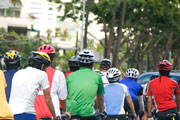North Carolina Pedestrian and Bicycle Crash Data Tool
About Bicycle Data
Data Resources
These data represent all bicycle-motor vehicle crashes reported to the NC Division of Motor Vehicles by investigating officers for the relevant crash years. Falls or other events involving only bicyclists that might be documented in medical databases are not included. While past research indicates that bicycle-motor vehicle crashes represent approximately 20-30% of all injuries to bicyclists, it is clear that most of the serious and fatal bicyclist injuries do involve motor vehicles. The UNC Highway Safety Research Center (HSRC) staff reviewed each bicycle (and pedestrian) crash report form, including diagrams and narratives, and coded every crash verified as involving at least one bicyclist to a specific crash type. Other crash factors such as age, sex, alcoholindicators of the bicyclist and driver, and roadway and environmental factors were obtained from NCDOT’s Crash Database, and added to the data.
Crash Facts and Crash Types
Crash typing is a methodology to better define the sequence of events and precipitating actions leading to a crash so that these types of crashes might be prevented. HSRC research staff used PBCAT (Pedestrian and Bicycle Crash Analysis Tool) software to perform the crash typing to identify a specific crash type for each crash. Other factors such as general location type (intersection, non-intersection, offroad), position (on a roadway lane, on a shoulder, on a sidewalk, off-roadway, etc.) and riding direction of the bicyclist were also captured. These data provide valuable insight that can help to select the most appropriate countermeasures.
More information, definitions and images of the crash types, and examples from communities that have used PBCAT, along with other resources, are available at http://www.pedbikeinfo.org/pbcat_us/index.cfm The software and user manual are available for free download at the same site.
This software was updated in 2006, resulting in some changes in the previous list of crash types. Thus, any new crash types would have 0 values shown in tables for all the years prior to 2006. Likewise, any of the previous crash types that were redefined would have 0 values for the years 2006 and after. For a complete list of the changes from version 1 to version 2, details are provided at http://www.pedbikeinfo.org/pbcat_us/manual.cfm; see "Supplement 1: V.1 to V.2 Crash types mapping."
Suitable countermeasures to help reduce occurrence of the more common types of crashes have been identified and described in resources including BIKESAFE, a countermeasure selection tool that was sponsored by the Federal Highway Administration.
An example of a bicycle-motor vehicle crash type is Motorist Left Turn – Opposite Direction. An example of a countermeasure for this crash type is installing a traffic signal or changing the signal timing at a high volume location to prevent uncontrolled left turns. Another example is installing a mini-traffic circle, which might be more appropriate at the intersection of two smaller streets.
Data Coverage and Uses
These data can be used to derive information about bicycle-motor vehicle crashes in NC. The user may select data in a variety of ways:
- For the entire state
- For the Piedmont, Coastal, and Mountain regions of the state
- For an individual county or selected counties
- For an individual city or selected cities
Please note that for some years no crashes were reported for some of the NC towns and cities.
Data like these are typically used to develop general descriptions of crashes. This process is sometimes referred to as the problem identification stage. For a detailed review of crashes in specific locations (e.g., corridors or certain intersections within a community), it will be necessary to obtain such information at the local level. Likewise, development of specific treatments or countermeasures normally takes place after discussions with knowledgeable local officials.

Need Help?
UNC Highway Safety Research Center
Libby Thomas
(919) 962-7802
NCDOT Division of Bicycle and Pedestrian Transportation
John Vine-Hodge
javinehodge@ncdot.gov
919-707-2607
- © Copyright NCDOT
- NCDOT Home
- NC.gov
- Accessibility
- Privacy Statement